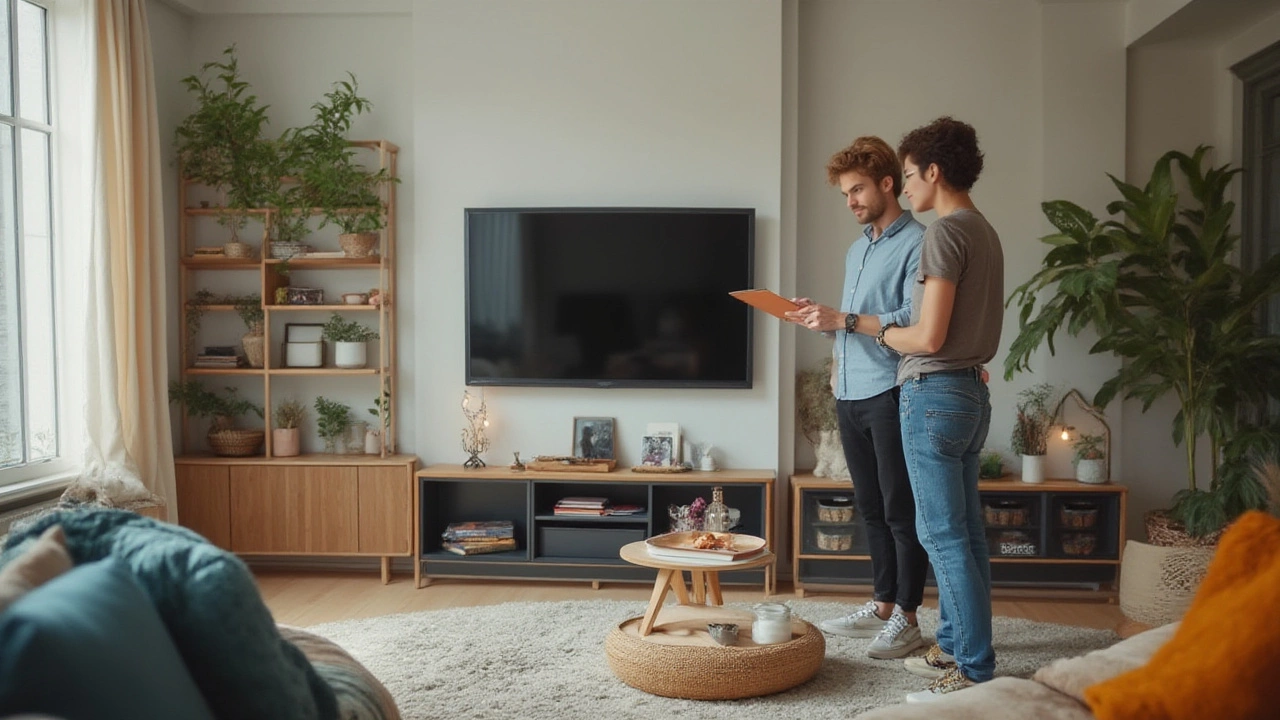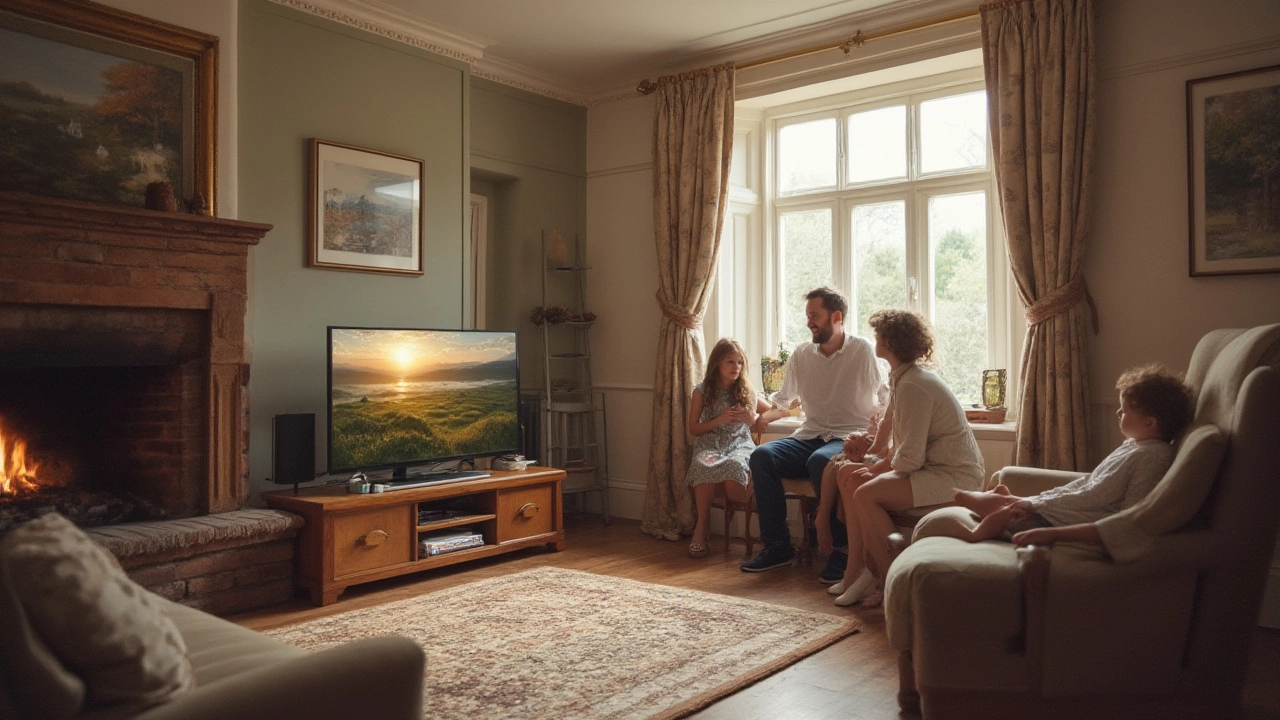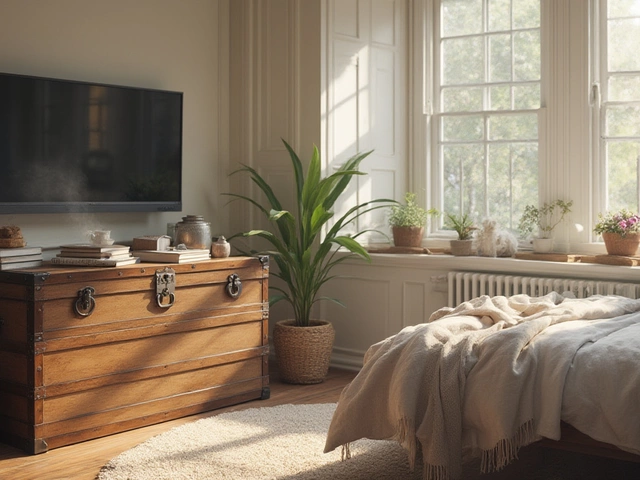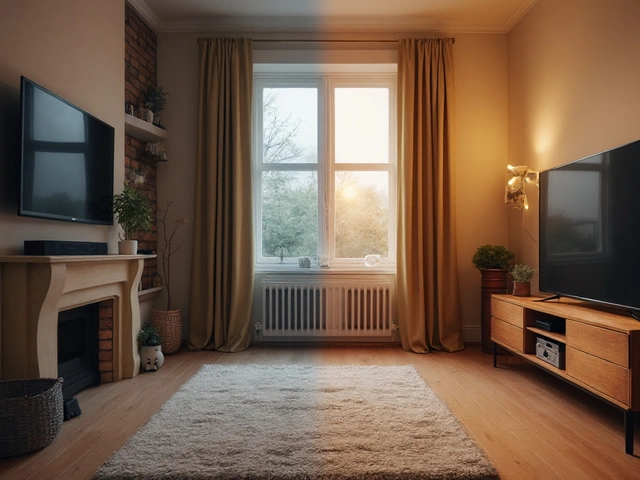Ever notice that the hardest decision in a living room isn’t the couch—it’s where to park your TV? People will argue over paint swatches and throw pillows for weeks, but when it comes to the TV, things just get weirdly intense. That glowing rectangle shapes the way a room works and feels more than most people want to admit. Nothing’s quite as awkward as binge-watching your favorite series from the wrong angle, or realizing the wires hanging down your wall make your place look like a dorm room. Let’s zero in on a decision lots of folks get stuck on: should you put your TV on a stand? Sounds simple, right? Let’s dig beyond the obvious answers—there’s more to it than you’d ever guess.
Why a TV Stand Still Makes Sense
Sticking your TV on a stand isn’t just about tradition or laziness. There are some solid, practical reasons this option works for so many people. It all starts with flexibility. A TV stand lets you move things around whenever you want. Want to angle the screen away from window glare, or shift your whole setup to create better “flow” in your room? Pretty easy if you’re not tethered to a wall mount. No drills, no patching up holes like an amateur drywall artist, no commitment-phobia. It’s the same reason folks still buy shelves instead of nailing boards to their walls forever.
Then there’s the wiring. I know, nothing kills a fancy streaming night like seeing a spaghetti mess of power cords. But let’s get real: TV stands usually have built-in options for hiding cables. A lot of newer stands come with slots, rear panels, and nifty holes that keep everything out of sight. Some stands even charge your devices—like, yeah, your phone and speakers get a home too, not just the TV. Wall mounts don’t always offer that unless you want to get into serious cable management (and most of us don’t have that kind of energy).
Here’s something a lot of people forget: storage. My stand used to be filled with remote controls, game consoles, my cat Whiskers’ secret stash of toys, and rows of old DVDs I swear I’ll donate someday. TV stand options are built with drawers, open slots, even glass cabinets for your collectibles. That just doesn’t happen with a wall mount—unless you like the “stuff stacked on the floor” look, which the internet keeps telling us is not “in.”
Think about your living room as a whole. Some people want their TV to be the main event. Others want it to fade into the background, just another part of the furniture. Stands help with that. Some designs blend right into your coffee table or sideboard vibe—mid-century chic, industrial, farmhouse rustic, you name it. And you don’t have to worry about the construction of your wall. Not every wall loves holding up a 75-inch TV. Plaster, thin drywall, old homes—not everything is a match made in heaven for heavy brackets and giant screens.
Safety is a huge part of this, too. Kids and pets (shout out to Whiskers, who bathes on my TV stand when he thinks I’m not looking) love to test the limits of gravity. Most new stands come with anti-tip kits or brackets you can use to anchor them to the wall just in case someone gets adventurous. Side note: according to the U.S. Consumer Product Safety Commission, nearly 70 children a year are killed by tip-over accidents—TVs and furniture make up a scary chunk of that. Stands with proper anti-tip hardware or weighted bases lower that risk way more than a wonky DIY setup.
TV Stands: What to Look for (and What to Avoid)
The best TV stand isn’t always the biggest or the fanciest. It’s about what works for your space, your TV, and your habits. Size is your first concern. TVs have gotten huge—today’s 65-inch monsters make what passed for a big screen ten years ago look like a postage stamp. Always check your stand’s weight and width limits compared to your TV. The last thing you want is the dreaded overhang, where the sides of the TV stick out like a slice of pizza over a too-small plate.
Material matters too. Woods and metals give different vibes, for sure, but also different strengths. MDF and particle board will do the job for lighter TVs, while solid wood or steel suits bigger, heavier screens. Glass looks modern but fingerprints can be a pain. And it better be tempered glass or you risk a disaster. For folks with rambunctious pets or traffic-heavy living rooms, go for sturdier, chunkier bases. Cats, dogs, and kids tend to test the definition of “stable.”
Think about height. You want your eyeballs hitting the center of the screen when you’re sitting. That means most stands need to put the TV screen about 42-48 inches off the ground, but measure your favorite seat. Recliners and sectionals change things up. Bonus points if your stand is adjustable—because not all couches are built the same.
Don’t forget ventilation. Consoles, streaming boxes, sound bars, routers, you name it—everything tech gets hot. Enclosed shelving with zero airflow might look sleek, but it’ll cook your hardware faster than you think. Look for open backs or slotted shelving, even discreet mesh cutouts, if you’re filling your stand with gadgets.
Some stands come with built-in mounts that let you “float” the TV above the base, giving a wall-mount look but with all the storage perks. Hybrids like those are awesome for renters or people who hate wall repairs, but still want that clean feel. Read the instructions—nothing kills the mood faster than realizing you’ve skipped a step that makes the whole thing wobble.
Here’s a quick view of popular stand materials, strengths, and tips:
| Material | Strength | Best For | Drawbacks |
|---|---|---|---|
| Solid Wood | Very Strong | Heavy TVs, Classic Decor | Heavy, Expensive |
| MDF/Particle Board | Decent (Less Durable) | Affordable, Light TVs | Can Sag Over Time |
| Steel/Metal | Very Strong | Modern Spaces, Durability | Industrial Look, Can Scratch |
| Glass (Tempered) | Surprisingly Strong | Minimal Modern Looks | Shows Smudges, Break Risk |

Comparing TV Stands to Wall Mounts: The Real Debate
So, why not mount your TV instead? The wall-versus-stand question gets people fired up. Mounting a TV frees up floor space, makes things look super clean, and puts the screen right at the perfect height—if you measure twice and drill once. But here’s where things get tricky. A mount is forever (or until you want to fill holes, repaint, and then start the debate all over). Renters, in particular, get nervous about drilling into the walls. Even homeowners worry about finding studs and not ending up with a crooked view for the next decade.
Wall mounts don’t give you storage, either. Even the thinnest soundbar needs a spot, and once you start running wires, you realize how fast “minimalist” turns into “where do I put my modem?” Some clever folks run cables inside the wall, but there are codes for that and sometimes it’s not possible—or legal—depending on your place. The risk of accidents goes up if you mount wrong or use the wrong bracket. TVs are heavier than you think, and sheetrock alone can’t cut it. Some smart TVs now require more power than a typical outlet, so hope you don’t end up with a weird extension cord running halfway around your room.
Also, your needs will change. Maybe you decide next year to rearrange your living room for better parties, or you move and have a totally different wall layout. That giant bracket you installed is now a decoration for the new owners. TV stands, in comparison, move when you do. No patch job required, just lift with your knees and hope your friends show up on moving day.
TV stands also minimize the risk of “TV too high” syndrome—when you strain your neck like you’re sitting in the front row of a movie theater. Wall mounts nearly always default to too-high setups, especially over fireplaces. Actual studies say the ideal TV center sits right around eye level from your main seat. That’s tough to nail without adjustable hardware, and even then, folks get it wrong. A stand is simple: set, sit, adjust, done.
Last, mounting isn’t always safe for families. Kids see a wall-mounted TV as a climbing challenge, and you don’t want to find your screen dangling from one screw. Stands can be anchored, and bonus, keep remotes and consoles out of sight and out of temptation’s way. Pet owners, if you’ve ever discovered a cat stretching on the corner of your warm TV stand, you get it—this isn’t just about screens, it’s about the life that happens around them.
Tips for Choosing the Perfect TV Stand for Your Life
Picking the right TV stand is a little like choosing a good mattress—size and comfort matter, but the details can make or break your day-to-day. Here’s how to shop smarter and make your screen time easier, prettier, and maybe even healthier.
- Measure everything. Treat your TV like royalty. Match the width of your stand to your TV plus a few inches on each side. Tape out space on the floor if you’re visual.
- Height matters. Sit in your favorite chair—your eye line should hit the center third of the screen. Adjust as needed, especially if your couch sits extra low or high.
- Plan for the future. If you might upgrade your screen in a year or two, get a stand that handles bigger sizes. Better too big than too small.
- Check the weight rating. Don’t trust looks alone. Find your TV’s weight on its manual or online and compare to the stand’s max load.
- Cable management is your best friend. Built-in cord covers, rear panels, and pass-through holes help keep things neat.
- Match your style, but don’t overdo it. Modern, rustic, mid-century—pick a stand that fits, but if you rotate your decor a lot, go for neutral colors and simple shapes.
- Think about your tech collection. Got a soundbar, gaming consoles, a router, or smart home hubs? Make sure there’s room and ventilation for all of it.
- Safety first. Use any anchoring kits supplied (or buy your own). Stands are safest when secured, especially on rugs or with kids and pets around.
- Don’t forget pet factor. If you’ve got a jumper or climber like Whiskers, pick a stand that’s sturdy enough to avoid wobbles or tragic leaps.
Shopping for a stand in 2025 means options. Adjustable heights, modular shelves, built-in lights, even motorized platforms aren’t just wish-list items anymore. The right pick should make movie night easier, gaming more fun, and your house feel more put together. If you’re going for resale value, buyers like seeing a living room that feels intentional—so a good TV stand sometimes pays for itself down the line.
So, should you put your TV on a stand? If you value flexibility, storage, safety, and a little design freedom, stands still beat wall mounting for most folks. Take your time and size up your real needs, not just what looks trendy right now. Your back, your neck, and—trust me on this—your cat will all thank you.



